Embark on a captivating journey through Norway's pristine landscapes to encounter a diverse array of wildlife, from majestic sea eagles to shy deer, in their natural Nordic habitats.
Norway's forests and mountains not only offer stunning scenery and abundant outdoor activities, but they also attract visitors eager to observe wild animals in their natural settings.
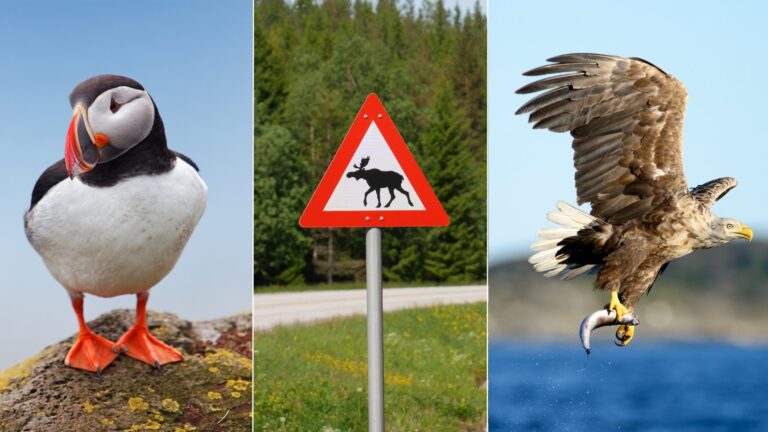
While the dwindling populations of brown bears and wolves can be challenging to spot, many of Norway's most emblematic animals are surprisingly approachable. Now, let's get into the details.
Brown Bears
The population of brown bears in Norway's forests has significantly dwindled. These bears hibernate throughout the winter and subsist on a diet of berries, plants, and occasionally sheep during the other seasons.
Øvre Pasvik National Park, located on the border with Finland and Russia in Norway's far northeast, remains one of the few places where brown bears are regularly observed.
Efforts to protect and monitor their population are critical to ensuring their presence remains a part of Norway's natural heritage.
Polar Bears in Svalbard
Historically, polar bear skeletons have been discovered as far south as Stavanger, but today, Norway’s polar bear population is confined to the Arctic archipelago of Svalbard.
Descended from brown bears, these formidable creatures have rapidly adapted to the severe Arctic conditions. Their diet primarily consists of ringed and bearded seals, and they traverse vast distances in their search for food.
Polar bears represent a real danger to both residents and visitors in Svalbard, making it mandatory for anyone leaving a settlement to carry a firearm for protection.
Nevertheless, lethal action against a polar bear is strictly regulated and can only be used as a last resort when there is an immediate threat to human life.
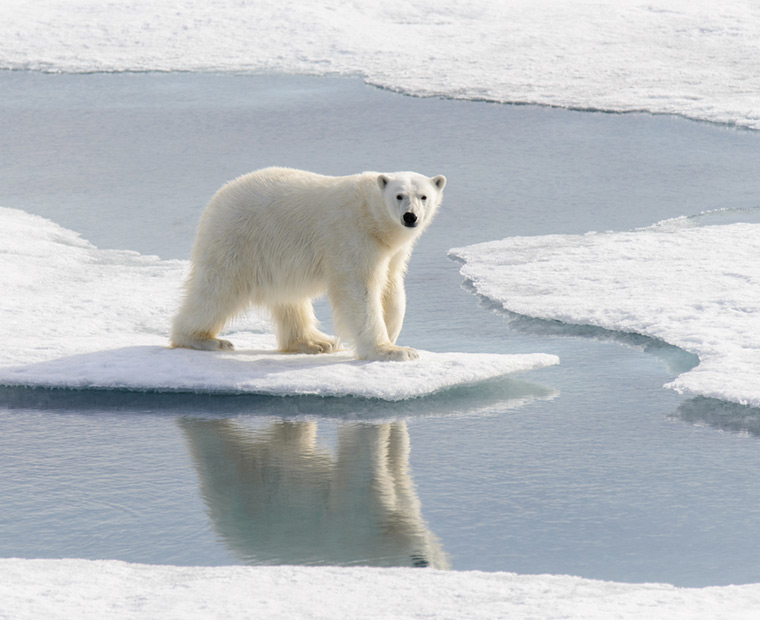
In addition to these safety measures, there are ongoing research and conservation efforts aimed at understanding and preserving this iconic species.
Scientists continuously study their habits, health, and habitats to gauge the impacts of climate change and human activities on their populations.
Visitors to Svalbard are required to respect these magnificent animals from a distance, ensuring safe and responsible wildlife watching.
Arctic Fox
The Arctic fox, now critically endangered with a population of just a few hundred, faces its greatest threat from the expanding numbers of the larger red fox.
Small groups of Arctic foxes are found in Svalbard, Børgefjell National Park, and Dovrefjell National Park, though they are rarely seen in the latter.
Exceptionally adapted to extreme winter conditions, the Arctic fox can withstand temperatures as low as -60°C due to its dense underfur.
While it is famed for its striking white winter coat, the Arctic fox's fur changes to a gray-brown hue during the summer months.
Elk (Moose)
Elk are widespread throughout Norwegian forests, but as you venture further north, they give way to reindeer populations. Hunting is a favoured pastime in Norway, yet despite this, their numbers remain robust, exceeding 100,000.
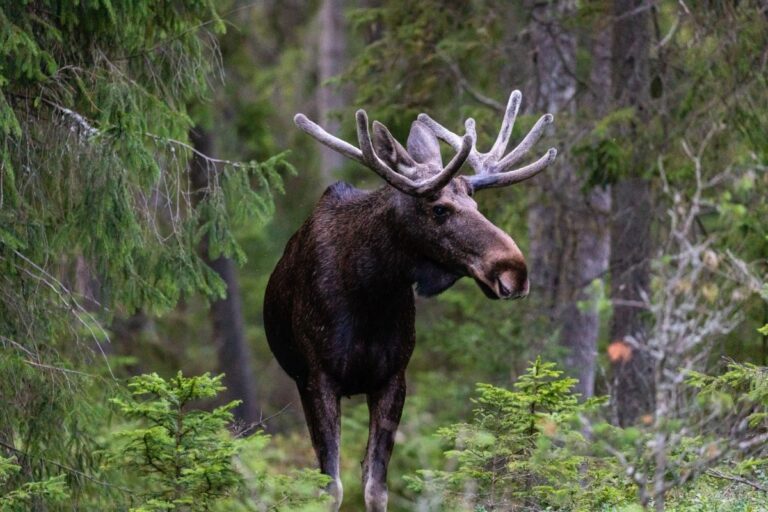
Spotting an elk with antlers can be particularly challenging; only males possess antlers, which they shed annually after the mating season to conserve energy for the upcoming winter.
As herbivores, elks may not seem threatening, but their imposing size can be startling, especially if encountered unexpectedly on a rural road. Adults can stand over two meters tall and weigh as much as 725 kg.
Deer
Deer, recognisable by their red-brown fur during the summer, are widespread across Norway's forests.
These herbivores, which include species like the red deer and the smaller roe deer, can grow up to 1.2 meters tall. The males of these species are particularly notable for their impressive antlers.
Known for their cautious nature, both red deer and roe deer are notoriously shy and are usually observed from a distance, blending into their natural surroundings to avoid close encounters with humans.
Reindeer
Reindeer are integral to the Sami culture, with herds freely grazing inland during the winter and migrating to coastal areas in the summer.
These animals, although naturally shy, are commonly seen meandering along rural roads in the north and do not typically flee when approached. Travellers passing through Finnmark are likely to encounter reindeer.
With a population exceeding 100,000, reindeer herding remains a sustainable practice. In northern Norway, reindeer meat is a staple in local cuisine.
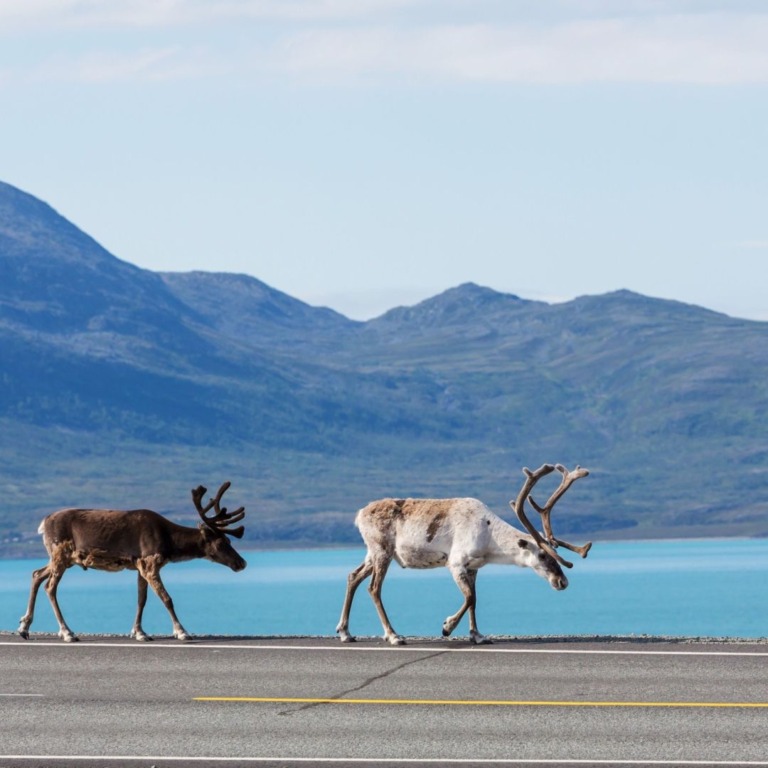
While the reindeer in the north are domesticated and owned by the Sami, wild reindeer can still be found roaming the central mountainous regions of Norway, including in Hardanger, Dovre, and Rondane National Parks.
Musk Ox
Besides the glaciers of central Norway, the musk ox serves as a prominent reminder of the last Ice Age. Nearly extinct at one point, these animals were reintroduced to Norway from Greenland about a century ago.
Today, Dovre National Park is one of the few places globally where musk oxen can be observed. Known for their dense fur and distinctive musky smell, male musk oxen are built to endure harsh conditions and can weigh more than 400 kg.
Lynx
Resembling a large domestic cat, the elusive lynx inhabits forested regions across Norway. Typically measuring over one metre in length, these solitary predators primarily feed on birds, hares, rodents, and occasionally sheep.
With their keen eyesight and stealthy movements, lynxes excel in hunting, making them formidable predators despite their elusive nature. They are seldom seen by humans.
Wolf
In the quiet expanse of Norway’s forests, the elusive wolf roams, often hidden from sight. These apex predators play a crucial role in the ecological balance, managing populations of deer and other animals.
Rarely seen, wolves are revered for their mystique and social structures, captivating those lucky enough to catch a glimpse of their shadowy figures.
Wolverine
The rugged terrain of Norway's wilderness is home to the wolverine, a solitary and fierce creature. Known for their strength and resilience, wolverines can travel great distances in search of food.
Despite their small size, they are formidable predators, often scavenging remains left by larger animals and facing harsh climatic conditions with remarkable endurance.
Historically, the wolverine was widespread across the Scandinavian Peninsula. However, during the 19th and 20th centuries, intense persecution significantly diminished both its range and population.
By 1970, the wolverine had nearly vanished from many areas, leaving its numbers critically low. However, protection policies have seen the wolverine population recover.
Birds
Home to 470 species of birds, including snowy owls, golden eagles, and Atlantic puffins, Norway is also a haven for bird-watchers throughout the year.
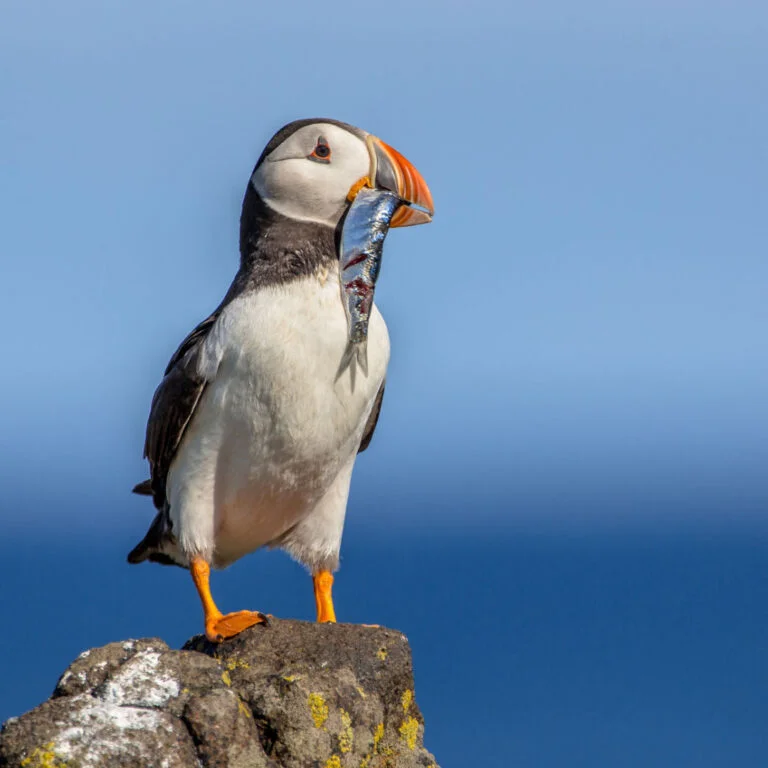
White-Tailed Sea Eagles are frequently sighted along Norway's coastline. These formidable birds are often observed gliding majestically over the cliffs.
Meanwhile, vibrant and engaging puffins are a common sight on numerous coastal islands in Norway throughout their breeding season.
Seabird Colonies
The secluded islands of Runde (off Ålesund) and Røst (near Lofoten) boast significant seabird colonies. Annually from February to August, Runde becomes a bustling nesting ground for over 100,000 birds, including kittiwakes, razorbills, gannets, and guillemots.
Despite its modest area of just 10 square kilometres, Røst supports one-quarter of Norway's seabird population, with a large number of Atlantic puffins.
However, challenges in finding sufficient food for their chicks have led to a drastic reduction in these birds' numbers, plummeting from 1.5 million to just 350,000 over the last 35 years.
Another prime location for bird enthusiasts is the Gjesværstappan bird cliffs on Magerøya Island, where the puffin population remains robust.
Here, puffins coexist with northern fulmars, kittiwakes, guillemots, shags, and arctic skuas on one of Norway’s largest bird cliffs, making it a vital and vibrant habitat for diverse avian species.
More Coastal Wildlife
Norway's extensive coastline is a treasure trove of marine wildlife, offering unique opportunities to observe a variety of creatures in their natural habitats.
Whales: The cold, nutrient-rich waters of Northern Norway, especially around Tromsø, are renowned for their whale watching tours.
Here, orcas and humpback whales are frequently sighted, providing spectacular displays as they breach and feed. These tours give visitors a front-row seat to some of the most majestic creatures of the ocean.
Seals: The rocky coasts of Norway are ideal resting spots for seals. Both the common harbor seal and the larger grey seal are regularly seen lounging on the rocks or playfully bobbing in the waters.
These marine mammals are a common sight along the entire Norwegian coastline, often seen sunning themselves or diving for fish.
Otters: Otters, with their playful antics and curious nature, are a delight to watch. These adaptable animals are found in both freshwater rivers and coastal areas across Norway.
Known for their swimming and hunting skills, otters can be observed sliding into the water, wrestling each other, or munching on their catch.
Norway’s Red List
Norway’s Red List comprises more than 2,000 species at risk of extinction, including a diverse array from beetles and fungi to vascular plants and lichens, with over half found in forests.
Among these, 276 are critically endangered, such as the bee Andrena hattorfiana, which thrives in dry pastures and is declining due to modern agricultural practices.
The basking shark is also endangered, having suffered from overhunting, though deliberate fishing within the Norwegian Economic Zone is now banned.
The Svalbard archipelago shelters 47 threatened species like the polar bear.
This list was compiled by 26 expert committees, involving over 100 members, who assessed over 20,000 species based on IUCN criteria.


Thanks for the informative article. One thing though: Norway is not “home to 470 species of birds”. That’s around the number of bird species ever recorded here, including accidentals and other rarities. But the number of bird species that breed here is closer to 250.
Most data in Norway gets aggregated or otherwise inflated artificially to make things appear to be better than they actually are. Norwegians can’t help themselves. Fact-checked, one of the worst places to be in Europe for most living things, including expats.
Pristine landscape? Norway’s landscape is primarily barren and mountainous. Spectacular in places, from a distance, but bleak close up. In terms of ecology (living nature/wildlife) it ranks among the worst places in Europe. Not simply due to its unfortunate geography (notably lack of soil) and miserable climate (including 6-month winter), but its historically impoverished economy and clearing of all natural woodlands. There are significantly more natural woodlands with infinitely more old trees in Britain than there are in Norway. And Britain ranks among the worst places for landscape change and wildlife losses. Where does that rank Norway? Do the ecology, not the engineered beliefs. All those ‘green cathedrals’ one sees while driving in Norway are, in fact, ecologically sanitised plantation forests. Toilet paper factories. As an ecologist with an interest in trees and woodland ecosystems, I have spent almost 30 years surveying forests in Norway in my spare time whilst travelling around on hiking trips, etc. One can walk in these monotonous plantations for hours to days without hearing or see a single bird or other animal. A genuinely eerie experience for a biologist who knows what should be there.
Norway does not have a pristine landscape at all. It looks ‘green’ because hardly anyone lives there. But it’s been over exploited and ruined more than Britain’s landscape, despite Norway being among the most sparsely populated places in Europe. A reflection of compulsive greed in a poor economy with very little respect for living things. As illustrated by the disturbing lack of ecologically valuable old trees in Norway’s landscape.
Sadly, the sea around Norway isn’t that great either. High pollution levels made worse by offshore oil extraction, salmon farms and, soon, mining the seabed, makes the seafood harvested around Norway measurably toxic necessitating health warnings and recommended limits on fish consumption, especially for children and women of child-bearing age.
I’m afraid the narrative Norway has a ‘pristine landscape’ is based on an engineered belief system, not ecology. Cherry picking photos of elk, wolf, puffin, etc. (before they get shot for ‘fun’) changes nothing about Norway being a tragic biodiversity cold spot.